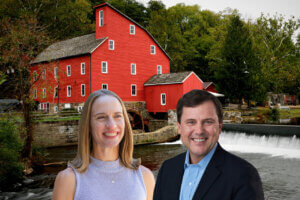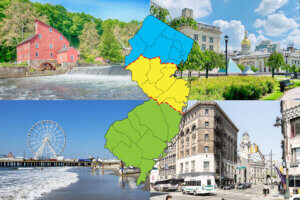Sandwiched between the New York and Philadelphia media markets, it is safe to say that New Jersey does not get its fair share of the airwaves. So when residents want to find out what’s going on in the state many turn to newspapers. More than 8-in-10 New Jerseyans are regular newspaper readers, picking up one of the state’s dailies at least once a week. This includes 42 percent who report reading the paper every day.
Nearly half (47%) of registered voters are daily readers compared to only 30 percent of non-voters. There are even greater disparities in newspaper readership by age. Fully 70 percent of New Jersey’s seniors age 70 and older are daily readers. This drops to 54 percent among the 50 to 69 age group, 39 percent among 30 to 49 year olds, and a paltry 20 percent among young adults age 18 to 29.
Newspapers are the great equalizer, though, when it comes to levels of education. College graduates (44%) are just as likely as those with only a high school diploma or less (45%) to read a newspaper every day. Oddly, residents who went on to college for just a couple of years are slightly less likely to be daily readers (37%).
In the contest to provide information on news and current affairs in the state, newspapers are the favored source. Nearly half (48%) of all residents say they rely on newspapers learn about Garden State politics and public affairs. Another 31 percent say they tend to turn on the television for this type of information. Other information sources listed as primary channels for obtaining news about New Jersey are radio (7%), Internet (6%) and word of mouth (4%).
There’s another interesting finding given the current campaign where two gubernatorial candidates are using their deep pockets to bombard the airwaves with ads. Voters who are currently undecided in their choice for governor are much more likely than supporters of either candidate to rely on newspapers rather than other sources for their news about the state. Among undecided voters, 61 percent get most of their information about state politics from newspapers compared to only 25 percent who rely on television.
Another important conduit of political information over the past few years has been the Internet. Campaign websites are now standard operating procedure. In the past year (which includes the 2004 presidential election), 1-in-5 residents (19%) reports having visited the website of a political candidate or organization. These political web-surfers tend to be college-educated and have higher incomes.
Both candidates in the current gubernatorial campaign have extensive websites (although it could be argued as to the amount of policy detail available on each). In the past year, 26 percent of Jon Corzine supporters and 21 percent of Doug Forrester backers have visited a political website (although not necessarily the site of a candidate in the current race). However, the undecided voters who these two candidates are actively wooing are the least likely to have seen any of their cyberspace material. Only 13 percent of undecided voters have visited a political website in the past year.
This recent Monmouth University/Gannett New Jersey Poll was conducted by telephone with 800 New Jersey adults from September 21 to 26, 2005. This sample has a margin of error of ± 3.5 percent.
TABLES – MUP01-7 / October 11, 2005
The questions referred to in this release are as follows:
(* Some rows may not add to 100% due to rounding.)
1. Where do you get most of your information about politics and public affairs in New Jersey—from newspapers, television, or somewhere else?
| Newspapers | TV | Radio | Internet | Word of Mouth | Other | DK | (n) | |
| September 2005 New Jersey Adults | 48% | 31% | 7% | 6% | 4% | 1% | 2% | (800) |
| Registered Voter | ||||||||
| –Yes | 51 | 30 | 7 | 5 | 4 | 1 | 2 | (649) |
| –No | 39 | 33 | 6 | 12 | 4 | 2 | 3 | (151) |
| Party ID | ||||||||
| –Democrat | 49 | 33 | 5 | 8 | 3 | 1 | 2 | (256) |
| –Independent | 54 | 27 | 5 | 6 | 6 | 1 | 1 | (237) |
| –Republican | 47 | 32 | 9 | 5 | 4 | 1 | 2 | (206) |
| Gender | ||||||||
| –Male | 53 | 26 | 8 | 7 | 3 | 0 | 2 | (383) |
| –Female | 44 | 36 | 6 | 6 | 5 | 1 | 2 | (417) |
| Education | ||||||||
| –HS or less | 51 | 32 | 6 | 5 | 4 | 1 | 2 | (249) |
| –Some college | 44 | 35 | 8 | 6 | 6 | 1 | 0 | (211) |
| –College grad | 48 | 27 | 7 | 10 | 4 | 1 | 3 | (324) |
| Age | ||||||||
| –18-29 | 39 | 34 | 5 | 11 | 9 | 2 | 1 | (93) |
| –30-49 | 48 | 29 | 8 | 9 | 4 | 1 | 1 | (295) |
| –50-69 | 53 | 31 | 7 | 2 | 3 | 0 | 3 | (271) |
| –70+ | 57 | 31 | 7 | 0 | 0 | 0 | 4 | (125) |
| Income | ||||||||
| –Under $50,000 | 45 | 36 | 5 | 5 | 6 | 1 | 2 | (284) |
| –$50-$100,000 | 46 | 32 | 10 | 7 | 3 | 0 | 1 | (222) |
| –Over $100,000 | 53 | 26 | 8 | 7 | 5 | 0 | 1 | (182) |
| Vote Intention | ||||||||
| –Forrester | 50 | 28 | 14 | 5 | 3 | 0 | 1 | (219) |
| –Corzine | 47 | 38 | 5 | 5 | 5 | 0 | 1 | (232) |
| –Undecided | 61 | 25 | 3 | 4 | 4 | 0 | 3 | (157) |
2. How often do you read a newspaper—every day, most days, at least once a week, or less often?
|
Every | Most days | Once a week | Less often |
(n) | |
|
September 2005 |
42% | 16% | 26% | 16% |
(800) |
| Registered Voter | |||||
| –Yes |
47 | 16 | 25 | 13 |
(649) |
| –No |
30 | 17 | 27 | 25 |
(151) |
| Party ID | |||||
| –Democrat |
42 | 17 | 27 | 13 |
(256) |
| –Independent |
46 | 17 | 24 | 13 |
(237) |
| –Republican |
49 | 14 | 24 | 13 |
(206) |
| Gender | |||||
| –Male |
44 | 16 | 26 | 14 |
(383) |
| –Female |
41 | 16 | 26 | 18 |
(417) |
| Education | |||||
| –HS or less |
45 | 13 | 26 | 16 |
(249) |
| –Some college |
37 | 15 | 31 | 17 |
(211) |
| –College grad |
44 | 22 | 20 | 14 |
(324) |
| Age | |||||
| –18-29 |
20 | 24 | 39 | 18 |
(93) |
| –30-49 |
39 | 19 | 27 | 15 |
(295) |
| –50-69 |
54 | 9 | 20 | 17 |
(271) |
| –70+ |
70 | 8 | 13 | 9 |
(125) |
| Income | |||||
| –Under $50,000 |
39 | 12 | 29 | 20 |
(284) |
| –$50-$100,000 |
43 | 18 | 25 | 13 |
(222) |
| –Over $100,000 |
49 | 19 | 21 | 10 |
(182) |
| Vote Intention | |||||
| –Forrester |
55 | 12 | 24 | 10 |
(219) |
| –Corzine |
42 | 19 | 28 | 11 |
(232) |
| –Undecided |
43 | 15 | 25 | 17 |
(157) |
3. In the past year, have you visited the internet website of a political candidate or organization?
|
Yes | No |
(n) | |
|
September 2005 |
19% | 81% |
(800) |
| Registered Voter | |||
| –Yes |
20 | 80 |
(649) |
| –No |
16 | 84 |
(151) |
| Party ID | |||
| –Democrat |
23 | 77 |
(256) |
| –Independent |
19 | 81 |
(237) |
| –Republican |
22 | 78 |
(206) |
| Gender | |||
| –Male |
23 | 77 |
(383) |
| –Female |
16 | 84 |
(417) |
| Education | |||
| –HS or less |
11 | 89 |
(249) |
| –Some college |
22 | 78 |
(211) |
| –College grad |
32 | 68 |
(324) |
| Age | |||
| –18-29 |
24 | 76 |
(93) |
| –30-49 |
24 | 76 |
(295) |
| –50-69 |
15 | 85 |
(271) |
| –70+ |
6 | 94 |
(125) |
| Income | |||
| –Under $50,000 |
11 | 89 |
(284) |
| –$50-$100,000 |
26 | 74 |
(222) |
| –Over $100,000 |
31 | 69 |
(182) |
| Vote Intention | |||
| –Forrester |
21 | 79 |
(219) |
| –Corzine |
26 | 74 |
(232) |
| –Undecided |
13 | 87 | (157) |
Results for this Monmouth University/Gannett NJ Poll are based on telephone interviews conducted September 21-26, 2005 with a statewide random sample of 800 adults, age 18 and older. For results based on the total sample, one can say with 95% confidence that the error attributable to sampling has a maximum margin of plus or minus 3.5 percentage points. Sampling error increases as the sample size decreases, so statements based on various population subgroups, such as separate figures reported by gender or party identification, are subject to more error than are statements based on the total sample. In addition to sampling error, one should bear in mind that question wording and practical difficulties in conducting surveys can introduce error or bias into the findings of opinion polls.
Click on pdf file link below for full methodology and results by key demographic groups.




